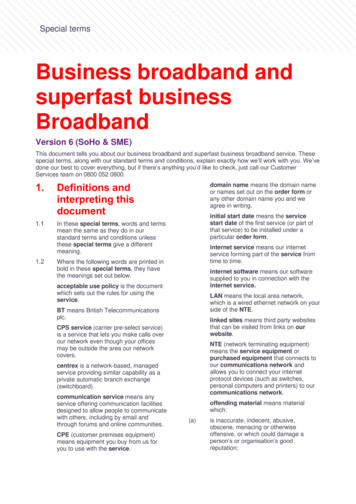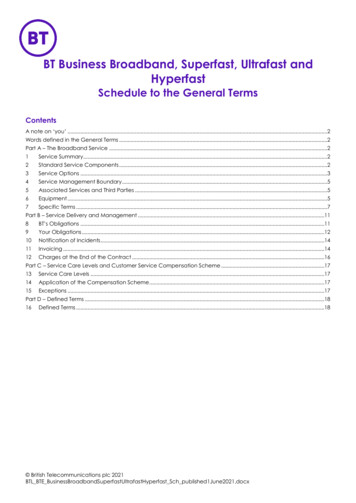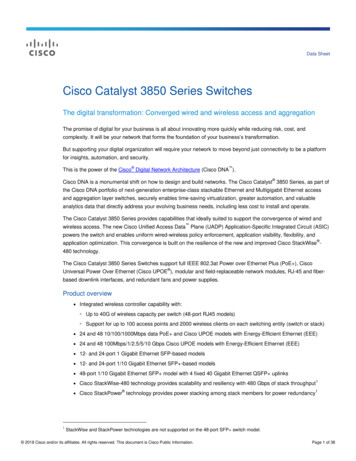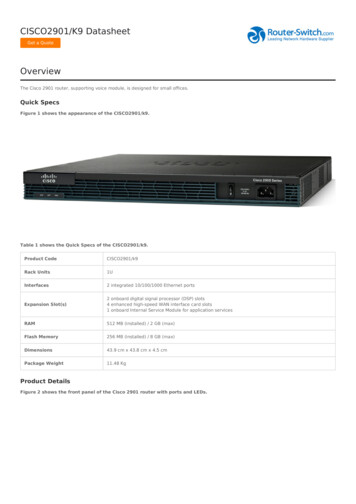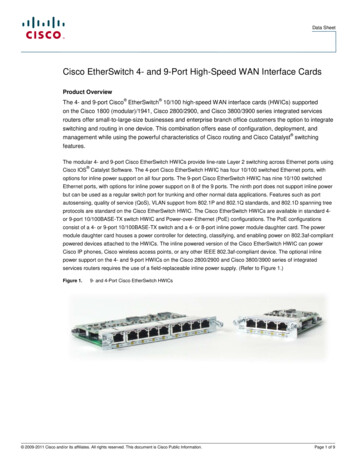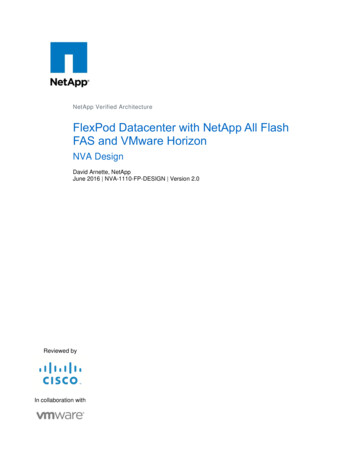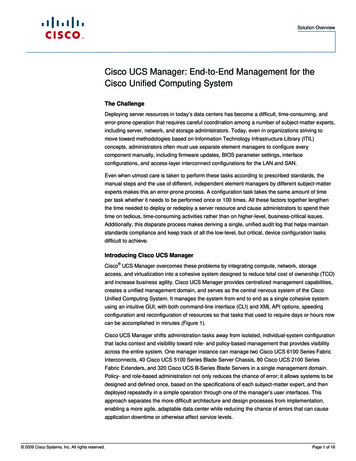
Transcription
BroadbandData Book 2020 Cisco and/or its affiliates. All rights reserved.
THE BROADBANDDATABOOKCable Access Business UnitSystems EngineeringRevision 21 2020 Cisco and/or its affiliates. All rights reserved.August 20191
Table of ContentsSection 1: INTRODUCTION . 4Section 2: FREQUENCY CHARTS . 6Section 3: RF CHARACTERISTICS OF BROADCAST TV SIGNALS . 28Section 4: AMPLIFIER OUTPUT TILT . 37Section 5: RF TAPS and PASSIVES CHARACTERISTICS . 42Section 6: COAXIAL CABLE CHARACTERISTICS . 64Section 7: STANDARD HFC GRAPHIC SYMBOLS . 72Section 8: DTV STANDARDS WORLDWIDE. 80Section 9: DIGITAL SIGNALS . 90Section 10: STANDARD DIGITAL INTERFACES .100Section 11: DOCSIS SIGNAL CHARACTERISTICS.108Section 12: FIBER CABLE CHARACTERISTICS.123Section 13: OPTICAL PASSIVES .127Section 14: PASSIVE OPTICAL NETWORKS .138Section 15: MPEG PACKET TRANSPORT .148Section 16: OPTICAL WAVELENGTH DESIGNATIONS.161Section 17: HFC PERFORMANCE CALCULATIONS .167Section 18: BROADBAND PARAMETERS .186Section 19: WEIGHTS and MEASURES .209 2020 Cisco and/or its affiliates. All rights reserved.2
NOTES ON THE REPRESENTATION OF NUMBERSThroughout this publication, numbers representing quantities (asdistinct from dates) are printed using the conventions of Englishspeaking countries. That is to say, the decimal point is represented bya period (.) and numbers greater than one thousand have their digitsordered in groups of three, with a comma (,) separating each group.Thus, the number one million, two hundred and thirty-four thousand,five hundred and sixty-seven point eight nine is written as:1,234,567.89It should be noted that the use of the period and the comma isreversed in many European countries. To avoid confusion, theconvention originated by ISO (International Organization forStandardization) and IEC (International Electrotechnical Commission) issometimes used. This recommends the use of the comma as anindicator of the decimal point, and a space instead of a comma toseparate the groups of three digits in large numbers. By thisconvention, the example given above becomes:1 234 567,89Note, however, that the date (year) is written without commas orseparators. 2020 Cisco and/or its affiliates. All rights reserved.3
Section 1: INTRODUCTIONCisco’s Broadband Data Book, Revision 21 (August 2019),represents the latest in a series of popular and informativepocket technical guides for the cable telecommunicationsindustry. Some new material has been added to what wasavailable in Revision 20 (July 2016), and much of the previousmaterial has been retained – some for historical referencepurposes. Every effort has been made to ensure the accuracyof the content of this publication. Any errors and omissions areunintentional. 2020 Cisco and/or its affiliates. All rights reserved.4
HOW TO USE CISCO’S BROADBAND DATA BOOKCarrying on a tradition started years ago at Scientific-Atlantawith what was originally called Technical Applications Data,then CATV Data Book, Cisco’s Broadband Data Book isintended to be used as a quick-reference guide for topicsrelated to broadband network technology. The contentprovided here has been compiled from various sources suchas product data sheets and industry standards andspecifications. For more in-depth information, you areencouraged to consult the original source material as well aspublications and other resources as noted.The Broadband Data Book is divided into multiple sections,each focusing on a particular technology and related topics(refer to the Table of Contents), helping to simplify locating thematerial of interest. For example, Section 6 includesattenuation and loop resistance specifications for severalmakes and sizes of hardline, subscriber drop, and headendcoaxial cables.Take a few minutes to thumb through this edition of theBroadband Data Book and familiarize yourself with the layoutand content. 2020 Cisco and/or its affiliates. All rights reserved.5
Section 2: FREQUENCY CHARTSNorth American Cable Channel Plan6 MHz-wide channel allocations used in North American and someother cable networks are defined in CTA Standard “Cable TelevisionChannel Identification Plan” CTA-542-D R-2018 (Formerly CTA-542D), updated February 2019.The original standard was developed by a joint EIA/NCTA committee,and was variously known as the EIA/NCTA, EIA, and IS-6 channelplans. The Consumer Electronics Association (now called theConsumer Technology Association) subsequently published updatedversions of the standard under the designation CEA-542. Version CEA542-D was renamed CTA-542-D after the Consumer ElectronicsAssociation changed its name to the Consumer TechnologyAssociation. The standard has since been updated to CTA-542-D R2018.Some in the industry still refer to 6 MHz-wide cable channels as ‘EIAchannels,’ but that designation was deprecated many years ago. Thecorrect terminology is ‘CTA channels.’The following related terms and definitions may be useful to the reader.channel – A portion of the electromagnetic spectrum usedto convey one or more RF signals between a transmitter andreceiver. May be specified by parameters such as start andstop frequencies, center frequency, bandwidth, or CTAchannel number.CTA-542-D R-2018 – A Consumer Technology Associationstandard that defines a channel identification plan for 6MHz-wide channel frequency allocations in cable networks.harmonic related carriers (HRC) – A method of spacingchannels in a cable television network defined in CTA-542D R-2018, in which visual carriers are multiples of 6.0003MHz. 2020 Cisco and/or its affiliates. All rights reserved.6
incremental related carriers (IRC) – A method of spacingchannels in a cable television network defined in CTA-542D R-2018, in which all visual carriers except channels 5 and6 are offset 12.5 kHz with respect to the standard channelplan. Channels 5 and 6 are offset 2.0125 MHz withrespect to the standard channel plan.single carrier quadrature amplitude modulation (SC-QAM) –The designation for legacy QAM signals carried on cablenetworks.standard frequencies (STD) – A method of spacingchannels in a cable television network defined in CTA-542D R-2018. Channels 2-6 and 7-13 use the samefrequencies as over-the-air channels 2-6 and 7-13. Othercable channels below Ch. 7 down to 91.25 MHz and aboveCh. 13 are spaced in 6 MHz increments.The following table includes examples of CTA-542-D R-2018 channelnumbers, visual carrier frequencies, and SC-QAM center frequencies(frequencies shown in MHz).STDCTA(analogChannel 066.003378.003984.0042 2020 Cisco and/or its affiliates. All rights reserved.STDIRCHRC(SC-QAM (SC-QAM (SC-QAMcentercentercenterfrequency) frequency) 0079.750085.7500
CATV channels(Standard frequency plan1)CTA channelDesignation2Channel 6.00282.00288.00294.00300.00North .2625295.2625 2020 Cisco and/or its affiliates. All rights 00261.00267.00273.00279.00285.00291.00297.008
CATV channelsCTA channelDesignation2North America (cont’d)Channel 565.2500571.2500 2020 Cisco and/or its affiliates. All rights 43.00549.00555.00561.00567.00573.009
CATV channelsCTA channelDesignation2North America (cont’d)Channel 00829.2500835.2500841.2500847.2500 2020 Cisco and/or its affiliates. All rights 0819.00825.00831.00837.00843.00849.00
CATV channelsCTA channelDesignation2North America (cont’d)Channel 152153154155156157158852.00 858.00858.00 864.00864.00 870.00870.00 876.00876.00 882.00882.00 888.00888.00 894.00894.00 900.00900.00 906.00906.00 912.00912.00 918.00918.00 924.00924.00 930.00930.00 936.00936.00 942.00942.00 948.00948.00 954.00954.00 960.00960.00 966.00966.00 972.00972.00 978.00978.00 984.00984.00 990.00990.00 996.00996.00 OTES:1. Incremental related carrier (IRC) and harmonic related carrier (HRC)frequency plans are excluded from this table because they areseldom encountered in today’s HFC networks.2. The ‘CTA’ channel numbers in the “new” column are those definedin the Consumer Technology Association standard CTA-542-D R2018. The “old” column shows historical channel designations.3. The center frequency is also the same as the suppressed carrierfrequency (SC-QAM signals are double sideband, suppressedcarrier RF signals). 2020 Cisco and/or its affiliates. All rights reserved.11
CATV channelsJapan(NTSC; standard M)Channel width: 6 MHzCh. .25283.25289.25295.25301.25Aural Ch. The chrominance subcarrier is located 3.57561149 MHz above the visual carrier. 2020 Cisco and/or its affiliates. All rights reserved.12
CATV channelsJapan (cont'd)Channel width: 6 MHzCh. 25609.25615.25621.25627.25633.25639.25645.25Aural Ch. .75U59631.75U60637.75U61643.75U62649.75 2020 Cisco and/or its affiliates. All rights 75757.75763.75769.75
CATV channelsPeople's Republic of China(PAL; standard D/K)Channel width: 8 MHzCh. 7.75485.75493.75 2020 Cisco and/or its affiliates. All rights reserved.Ch. 05.75813.75821.75829.75837.75845.75853.75861.75
CATV channelsEurope(PAL; standard B/G)Channel width: 7 and 8 MHzCh. No.VisualAural 7 MHz channel spacing 1.75278.75285.75292.75299.75Ch. No.VisualAural 8 MHz channel spacing 0.75548.75556.75564.75572.75580.75588.75NOTE:The channels E2 through E69 are designated K2 through K69 in Germany. 2020 Cisco and/or its affiliates. All rights reserved.15
CATV channelsCh. No.VisualEurope (cont'd)AuralCh. No.VisualAural 8 MHz channel spacing 8 MHz channel spacing 2.75860.75NOTE:The channels E2 through E69 are designated K2 through K69 in Germany. 2020 Cisco and/or its affiliates. All rights reserved.16
CATV channelsUnited Kingdom(PAL; ITU-R* standard I)Channel width: 8 .0814.0822.0830.0838.0846.0854.0862.0870.0 2020 Cisco and/or its affiliates. All rights reserved.17
Over-the-air channelsChanneldesignationChannel limitsbottomtopNorth America(ITU-R standard M [NTSC]and ATSC A/53B [8-VSB])Analog visual 8-VSB suppressedcarriercarrierLow .31596.31602.31608.31614.31620.31626.31High VHFUHF 2020 Cisco and/or its affiliates. All rights reserved.18
Over-the-air annel th America (cont’d)Analog visual 8-VSB 692.31NOTES:At the time of printing of this Databook, all high-power over-the-air TV transmittersin the United States have made the conversion to digital transmission. Most ofthese transmissions use the UHF band, but some can be found in the low- andhigh-VHF bands. Low-power transmitters and translators may continue tobroadcast analog TV signals.The 698 MHz to 806 MHz over-the-air spectrum containing the former UHF TVchannels 52-69 has been reallocated to other services such as long term evolution(LTE) and public safety communications.A 600 MHz incentive auction concluded in early 2017, which paved the way forreassignment of UHF TV channels 38-51 for wireless services. TV broadcasters arevacating those channels and either going off the air altogether or moving to alower-frequency channel during a multi-year, 10-phase transition schedule, slatedto be complete by mid-2020. 2020 Cisco and/or its affiliates. All rights reserved.19
VHF over-the-air channelsITU-R standards B,D,I & LChannel BW (MHz)VisualAuralEurope (standard B); 7 1E12S11S12S13S14S15S16S17S18S19S2047 – 5454 – 6161 – .75257.75264.75271.75278.75285.75292.75299.75 2020 Cisco and/or its affiliates. All rights reserved.20
Australia (standard B); 7 MHzspacing0123455A6789101145 – 5256 – 6363 – 7085 – 5214.75221.75 2020 Cisco and/or its affiliates. All rights reserved.21
VHF over-the-air channelsITU-R standards B,D,I & L (cont’d)Channel BW (MHz)VisualAuralItaly (standard B); 7 MHzspacingABCDEFGHH1H252.5-59.561 – 6881 – 215.75222.75229.75Morocco (standard B); 7 MHzspacingM4M5M6M7M8M9M 76.75184.75192.75200.75208.75216.75New Zealand (standard B);7 MHz spacing1234567891044 – 5154 – 6161 – .75215.75222.75 2020 Cisco and/or its affiliates. All rights reserved.22
People's Rep. of China(standard D);8 MHz VHF over-the-air channelsITU-R standards B,D,I & L (cont’d)Channel BW (MHz)VisualAuralOIRT* (standard D); 8 MHzspacingRIR IIR IIIR IVRVR VIR VIIR VIIIR IXRXR XIR XII48.5-56.558 – 6676 – 8484 – 9292 – 189.75197.75205.75213.75221.75229.75Ireland (standard I); 8 .7559.7567.75181.25189.25197.25205.25213.25221.25 2020 Cisco and/or its affiliates. All rights reserved.23
South Africa (standard I);8 MHz 6206-214214-222222-230230-238238-246246-254175.25 181.25183.25 189.25191.25 197.25199.25 205.25207.25 213.25215.25 221.25223.25 229.25231.25 237.25not defined247.25 253.25* OIRT: Organisation Internationalede Radiodiffusion-Télévision.This organization represented thebroadcasters of Eastern Europeancountries. In 1993 it was incorporatedinto the European BroadcastingUnion (EBU). 2020 Cisco and/or its affiliates. All rights reserved.24
VHF over-the-air channelsITU-R standards B,D,I & L (cont’d)ChannelBW (MHz)VisualAuralFrance (standard L); 8 MHzspacingABCC112345641 – 4949 – 5757 – n (standard M); 6 MHzspacingJ190 – 9691.25J296 – .25J6182-188183.25J 7*188-194189.25J 8*192-198193.25J9198-204199.25J 10204-210205.25J 11210-216211.25J 12216-222217.25* Channel spacing is 4 203.75209.75215.75221.75 2020 Cisco and/or its affiliates. All rights reserved.25
UHF over-the-air channelsITU-R standards G, H, I, K & LCHANNELEuropeP.R.ChinaUHF band 2021222324NotdefinedBW 813.75UHF band 84950 2020 Cisco and/or its affiliates. All rights reserved.26
UHF over-the-air channelsITU-R standards G, H, I, K
CATV Data Book, Cisco’s Broadband Data Book is intended to be used as a quick-reference guide for topics related to broadband network technology. The content provided here has been compiled from various sources such as product data sheets and industry standards a

